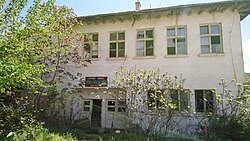
Blagoevgrad is а town in Southwestern Bulgaria, the administrative centre of Blagoevgrad Municipality and of Blagoevgrad Province. With a population of almost 70,000 inhabitants, it is the economic and cultural centre of Southwestern Bulgaria. It is located in the valley of the Struma River at the foot of the Rila Mountains, 101 kilometres south of Sofia, close to the border with North Macedonia.

Blagoevgrad Province, also known as Pirin Macedonia or Bulgarian Macedonia, is a province (oblast) of southwestern Bulgaria. It borders four other Bulgarian provinces to the north and east, the Greek region of Macedonia to the south, and North Macedonia to the west. The province has 14 municipalities with 12 towns. Its principal city is Blagoevgrad, while other significant towns include Bansko, Gotse Delchev, Melnik, Petrich, Razlog, Sandanski, and Simitli.

Gotse Delchev, is a town in Gotse Delchev Municipality in Blagoevgrad Province of Bulgaria.

Petrich is a town in Blagoevgrad Province in southwestern Bulgaria, located in Sandanski–Petrich Valley at the foot of the Belasica Mountains in the Strumeshnitsa Valley. According to the 2021 census, the town has 26,778 inhabitants.

Belitsa is a town in southwestern Bulgaria, located in the Belitsa Municipality of the province of Blagoevgrad.

Yane Sandanski was a Macedonian Bulgarian revolutionary. He is recognized as a national hero in both Bulgaria and North Macedonia.

The Vilayet of Kosovo was a first-level administrative division (vilayet) of the Ottoman Empire in the Balkan Peninsula which included the current territory of Kosovo. The areas today comprising Sandžak (Raška) region of Serbia and Montenegro, although de jure under Ottoman control, were in fact under Austro-Hungarian occupation from 1878 until 1909, as provided under Article 25 of the Treaty of Berlin.

Ano Poroia is a village in Greece, located in Macedonia. The population was 965 people (2011).

The People's Federative Party (Bulgarian Section) (Bulgarian: Народна федеративна партия (българска секция)) was a Bulgarian political party in the Ottoman Empire, created after the Young Turk Revolution, by members of the left wing of the Internal Macedonian Adrianople Revolutionary Organization (IMARO). The party functioned for one year from August 1909 until August 1910. The Party decided to name itself Bulgarian Section, since it was hoped that other nationalities from European Turkey would adopt its program and form their own ethnic sections, but this didn't happen. Its main political rival was the Union of the Bulgarian Constitutional Clubs.

The Miss Stone Affair was the kidnapping of American Protestant missionary Ellen Maria Stone and her pregnant Bulgarian fellow missionary and friend Katerina Cilka by the pro-Bulgarian Internal Macedonian Revolutionary Organization.
Buchino is a sparsely inhabited village in Blagoevgrad Municipality, in Blagoevgrad Province, Bulgaria. It is situated on the foothills of Vlahina mountain 13 kilometers northwest of Blagoevgrad.
Koprivlen is a village in Hadzhidimovo Municipality, in Blagoevgrad Province, Bulgaria.
Laki is a village in Hadzhidimovo Municipality, in Blagoevgrad Province, Bulgaria.

Nova Lovcha is a village in Hadzhidimovo Municipality, in Blagoevgrad Province, Bulgaria.
Novo Leski is a village in Hadzhidimovo Municipality, in Blagoevgrad Province, Bulgaria.
Paril is a village in Hadzhidimovo Municipality, in Blagoevgrad Province, Bulgaria.

Sadovo is a village in Hadzhidimovo Municipality, in Blagoevgrad Province, Bulgaria.

During the decline and dissolution of the Ottoman Empire, Muslim inhabitants living in territories previously under Ottoman control, often found themselves as a persecuted minority after borders were re-drawn. These populations were subject to genocide, expropriation, massacres, religious persecution, mass rape, and ethnic cleansing.

Kastanoussa, known before 1926 as Palmes, is a village in Serres with a population of 592 inhabitants as recorded in the 2011 census. The village and community belongs to the municipality of Sintiki.

Platanakia, known before 1922 as Sugova / Shugovo is a village in Serres, Greece. It is situated in the municipal unit of Kerkini, in the Sintiki municipality, within the Serres region of Central Macedonia. The village had 697 inhabitants according to the 2001 census. The population was 444 according to the 2011 census.















